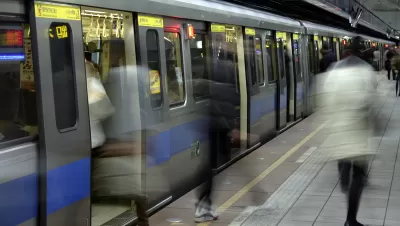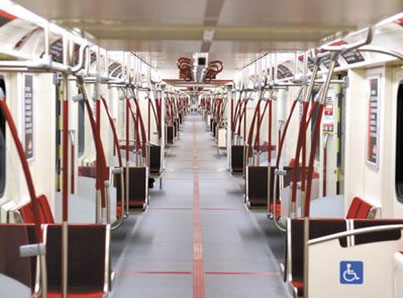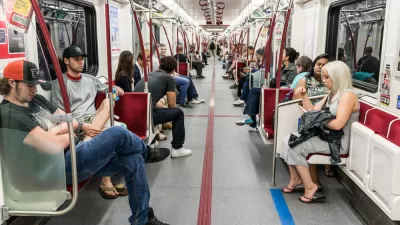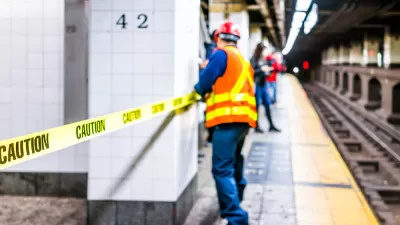Yonah Freemark examines U.S. subway systems and notes the lack of "open gangways" (i.e., the space between the cars). Only in the U.S. do doors separate cars. What gives?

"All around the world, cities investing in their metros—a term I’ll use here to describe systems like New York’s Subway, the Bay Area BART, and others—are choosing to include open gangways on their trains,*" writes Freemark. "It’s a simple concept to understand: Basically, people who board a train are able to walk from one end of the train to the other without opening doors or stepping outside of the train."
Credit: Bombardier Healthy Transit News. The new Toronto Subway cars have open gangways allowing riders to walk freely from one end of the train to the other.
I experience that free-walking through the train almost daily when I board my Caltrain close to departure time in San Francisco—all the doors are open between cars so late-arriving passengers can board the crowded first car and walk to the least crowded fifth car, but Freemark is not writing about commuter rail, only metros, a term essentially synonymous with subways. The Federal Transit Administration's (FTA) National Transit Database defines both under the term "Heavy Rail (HR)," which does not refer to the weight of the train but the volume of traffic:
A transit mode that is an electric railway with the capacity for a heavy volume of traffic. It is characterized by:
Back to Caltrain for a moment. Shortly after departure, a conductor walks through the train and closes the "gangway" doors. As a result I see passengers struggle to open the doors if they want to move between cars.
Freemark lists the ways open gangways are superior to closed ones.
One, they expand capacity by allowing riders to use the space that typically sits empty between cars. This added capacity means that a metro line can carry more people with trains of the same length.
Two, it allows passengers to redistribute themselves throughout the train while the vehicle is moving, reducing problems associated with many people boarding in the same doorway, such as slow exiting times and poorly distributed standees.
Three, it increases safety at times of low ridership by increasing the number of “eyes” in the train.
Even our compatriots just across the border in Montreal and Toronto have come around. Every major train manufacturer offers trains with open gangways off the shelf. What is holding U.S. systems back?
Freemark wonders if the problem could be "petrified management, stuck in an older technological age and unable to try something new."
The New York Times covered the topic—rather positively, as Freemark notes, by Matt Flegenheimer back in June 2013 after the New York Metropolitan Transportation Authority (MTA) included open gangways in their "Twenty-Year Capital Needs Assessment 2015-2034" [PDF] on the issue.
This month, in a 142-page document outlining needs for the next 20 years, the authority noted the benefits of articulated [*] trains — similar to accordion-style buses — that have no doors between cars, allowing unrestricted flow throughout the length of the subway. “This will both maximize carrying capacity,” the authority said, and allow passengers to “move to less-crowded areas of the train, balancing loading and unloading times at all doors.”
Writing about the 2013 MTA report in Second Ave Sagas, Benjamin Kabak provides the answer to the title question of this post.
As a (Regional Plan Association) official noted to The Times, New York City is well behind the curve, and it’s time to catch up. “We’re one of the largest systems in the world that doesn’t do it,” Richard Barone, the RPA’s director of transportation programs, said. “Our trains don’t function right now to allow people to circulate.”
A footnote by Freemark:
* You could call trains with open gangways “articulated,” but this typically refers to a specific type of gangway, often where the truck (the bogies, where the wheels are) is right below the gangway. A traditional train would have two trucks supporting each car (a 10-car train would have 20 trucks), but an articulated train might have every two cars sharing one truck, such that a 10-car train could have as few as just 11 trucks, vastly reducing weight and energy consumption.
I was able to find one criticism of open gangways as a consideration for New York's Second Ave. Subway in the form of a YouTube video from BVEstation. If you miss New York's subway, it's worth a listen:
OpenBVE NYC: Why Open Gangways In Between Cars Would Be Impractical for the R211
Hat Tip: Karl Kenyon, Sierra Club Transportation Forum.
FULL STORY: When American transit agencies ignore the world’s move to open gangways

Trump Administration Could Effectively End Housing Voucher Program
Federal officials are eyeing major cuts to the Section 8 program that helps millions of low-income households pay rent.

Planetizen Federal Action Tracker
A weekly monitor of how Trump’s orders and actions are impacting planners and planning in America.

The 120 Year Old Tiny Home Villages That Sheltered San Francisco’s Earthquake Refugees
More than a century ago, San Francisco mobilized to house thousands of residents displaced by the 1906 earthquake. Could their strategy offer a model for the present?

HSR Reaches Key Settlement in Northern California City
The state’s high-speed rail authority reached an agreement with Millbrae, a key city on the train’s proposed route to San Francisco.

Washington State Legislature Passes Parking Reform Bill
A bill that would limit parking requirements for new developments is headed to the governor’s desk.

Missouri Law Would Ban Protections for Housing Voucher Users
A state law seeks to overturn source-of-income discrimination bans passed by several Missouri cities.
Urban Design for Planners 1: Software Tools
This six-course series explores essential urban design concepts using open source software and equips planners with the tools they need to participate fully in the urban design process.
Planning for Universal Design
Learn the tools for implementing Universal Design in planning regulations.
Ada County Highway District
Clanton & Associates, Inc.
Jessamine County Fiscal Court
Institute for Housing and Urban Development Studies (IHS)
City of Grandview
Harvard GSD Executive Education
Toledo-Lucas County Plan Commissions
Salt Lake City
NYU Wagner Graduate School of Public Service





























